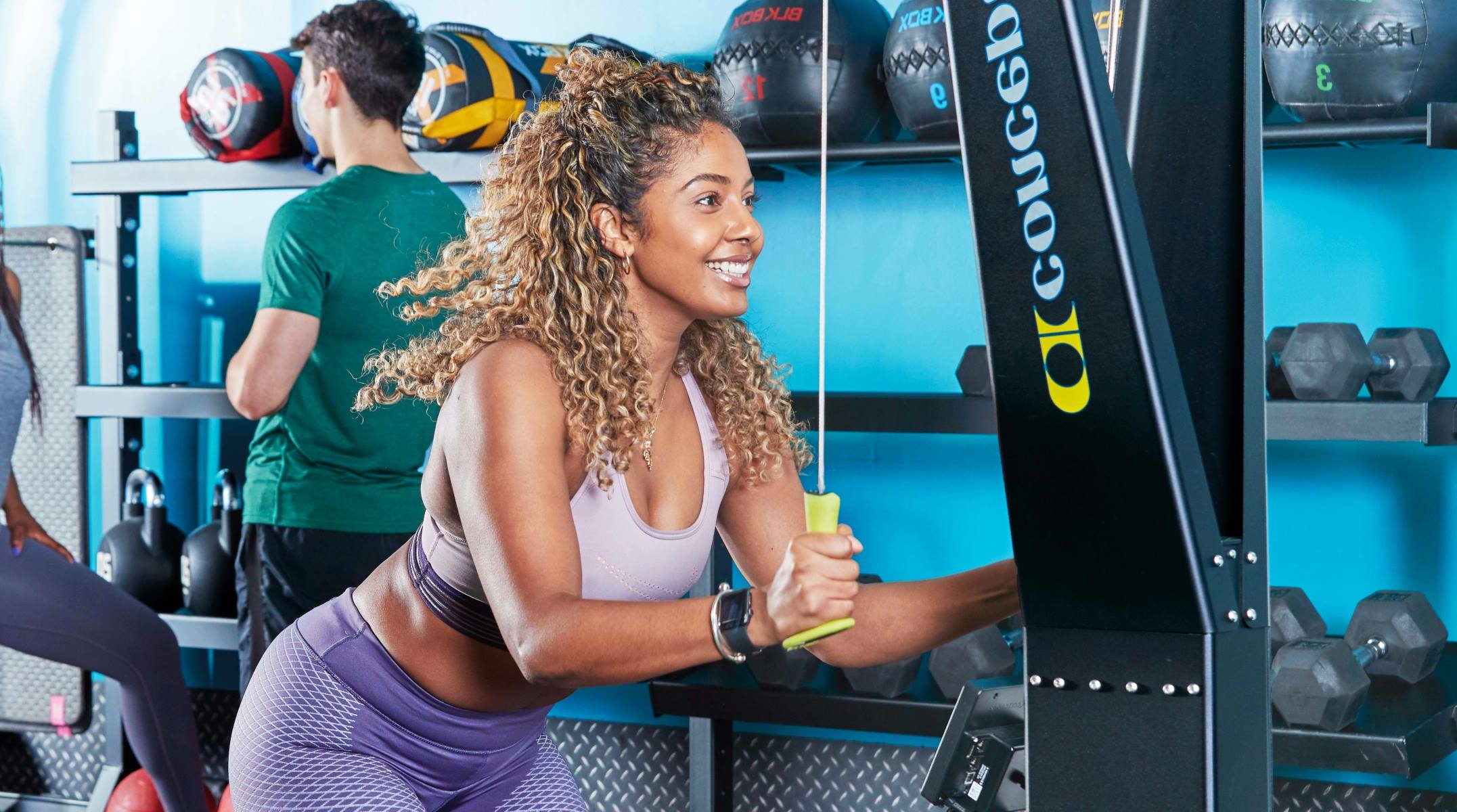Home>Training & Techniques>Cross-Training>Boost Your Running Performance With These CrossFit Workouts


Cross-Training
Boost Your Running Performance With These CrossFit Workouts
Published: February 20, 2024
Improve your running performance with effective CrossFit workouts designed for cross-training. Enhance your strength, endurance, and agility with these dynamic exercises.
(Many of the links in this article redirect to a specific reviewed product. Your purchase of these products through affiliate links helps to generate commission for Therunningadvisor.com, at no extra cost. Learn more)
Table of Contents
The Benefits of CrossFit for Runners
CrossFit has gained immense popularity in the fitness world, and for good reason. It offers a myriad of benefits for runners looking to enhance their performance and overall fitness levels. Incorporating CrossFit workouts into a runner's training regimen can lead to significant improvements in speed, endurance, strength, and flexibility. Let's delve into the specific advantages that CrossFit brings to the table for runners.
-
Full-Body Conditioning: CrossFit workouts are designed to target multiple muscle groups simultaneously, providing a comprehensive full-body workout. This holistic approach is particularly beneficial for runners as it helps in strengthening not only the leg muscles but also the core, arms, and back. A well-rounded strength and conditioning program is essential for runners to minimize the risk of injuries and improve overall performance.
-
Functional Strength: CrossFit emphasizes functional movements that mimic real-life activities, making it highly relevant for runners. By incorporating exercises such as squats, deadlifts, and kettlebell swings, runners can develop the strength and power necessary to propel themselves forward with each stride. This functional strength translates directly to improved running efficiency and speed.
-
High-Intensity Interval Training (HIIT): Many CrossFit workouts are structured around high-intensity interval training, which involves alternating between short bursts of intense exercise and brief recovery periods. This type of training is incredibly effective for improving cardiovascular endurance, a crucial factor for runners aiming to sustain their pace over long distances.
-
Variety and Adaptability: CrossFit offers a diverse range of workouts, ensuring that runners can avoid monotony and continuously challenge their bodies in new ways. From weightlifting and gymnastics to plyometric exercises and endurance drills, the versatility of CrossFit training keeps the body adaptable and responsive, preventing plateaus in performance.
-
Community and Motivation: Engaging in CrossFit classes or group workouts fosters a sense of community and camaraderie among participants. This supportive environment can be a valuable source of motivation for runners, encouraging them to push their limits and stay committed to their training goals.
In summary, CrossFit presents a holistic approach to fitness that aligns closely with the needs of runners. By integrating CrossFit workouts into their training routines, runners can reap the benefits of improved full-body conditioning, functional strength, enhanced endurance, workout variety, and a supportive community. These advantages collectively contribute to elevating a runner's performance and overall well-being, making CrossFit a valuable complement to traditional running training.
CrossFit Workouts to Improve Speed and Endurance
CrossFit workouts are renowned for their ability to enhance speed and endurance, making them an invaluable addition to a runner's training regimen. By incorporating specific CrossFit exercises and training methodologies, runners can effectively target the key components that contribute to improved speed and endurance.
High-Intensity Interval Training (HIIT)
High-Intensity Interval Training (HIIT) lies at the core of many CrossFit workouts and is particularly beneficial for runners aiming to boost their speed and endurance. HIIT involves alternating between short bursts of intense exercise and brief recovery periods. This approach effectively elevates the heart rate, enhances cardiovascular capacity, and improves the body's ability to utilize oxygen, all of which are crucial for sustaining speed and endurance during runs.
Sprint Intervals
Sprint intervals are a staple in CrossFit training and are highly effective for improving speed and endurance. By incorporating short, intense sprints into their workouts, runners can significantly enhance their anaerobic capacity and leg muscle strength. Sprint intervals not only contribute to increased speed but also aid in developing the explosive power necessary for surging ahead during races and maintaining a strong pace over extended distances.
Plyometric Exercises
Plyometric exercises, such as box jumps, burpees, and jump squats, are integral to CrossFit workouts and play a pivotal role in enhancing speed and endurance for runners. These explosive movements engage fast-twitch muscle fibers, which are essential for generating quick and powerful movements. By integrating plyometric exercises into their training, runners can improve their leg strength, agility, and overall explosiveness, leading to enhanced speed and endurance on the track or trail.
Endurance-Oriented Workouts
CrossFit offers a diverse array of endurance-focused workouts that are specifically designed to challenge and improve a runner's stamina. These workouts often incorporate a combination of bodyweight exercises, kettlebell movements, and cardiovascular activities, creating a comprehensive training stimulus that targets both muscular endurance and cardiovascular capacity. By regularly engaging in these endurance-oriented workouts, runners can fortify their ability to maintain a steady pace and push through fatigue during long-distance runs.
Tempo Runs and CrossFit
Integrating tempo runs, which involve sustained efforts at a challenging but manageable pace, with CrossFit workouts can yield remarkable improvements in speed and endurance. By strategically aligning these two training modalities, runners can optimize their aerobic threshold, improve their lactate threshold, and cultivate the mental fortitude required to sustain a demanding pace over extended periods.
Incorporating these CrossFit workouts into a runner's training routine can yield substantial improvements in speed and endurance, ultimately translating to enhanced performance on the track, road, or trail. By leveraging the diverse array of training methodologies and exercises offered by CrossFit, runners can effectively target the specific physical attributes and energy systems that underpin speed and endurance, thereby elevating their overall running capabilities.
Strength Training Exercises for Runners
Strength training is a fundamental component of a well-rounded running regimen, and when integrated with CrossFit workouts, it can yield remarkable benefits for runners. By focusing on specific strength training exercises tailored to the needs of runners, individuals can effectively enhance their muscular strength, power, and overall running performance.
Squats and Variations
Squats are a cornerstone of strength training for runners, as they target the quadriceps, hamstrings, glutes, and core muscles, all of which are essential for running efficiency and injury prevention. In addition to traditional squats, variations such as front squats, goblet squats, and single-leg squats can be incorporated to add variety and challenge different muscle groups.
Read more: Boost Your Running Performance With Protein
Deadlifts
Deadlifts are highly effective for developing lower body strength, particularly in the hamstrings, glutes, and lower back. By performing deadlifts with proper form and gradually increasing the resistance, runners can enhance their posterior chain strength, which is crucial for generating power and maintaining proper running mechanics.
Lunges and Step-Ups
Lunges and step-ups are unilateral exercises that help address muscle imbalances and enhance stability. These exercises target the quadriceps, hamstrings, and glutes while also engaging the core for balance and coordination. By incorporating lunges and step-ups into their strength training routine, runners can improve their overall lower body strength and stability, leading to more efficient and resilient running mechanics.
Kettlebell Swings
Kettlebell swings are a dynamic exercise that engages the posterior chain, including the hamstrings, glutes, and lower back. This explosive movement not only enhances muscular strength and power but also improves hip mobility and coordination, which are essential for generating force during running strides.
Pull-Ups and Rows
Upper body strength is often overlooked in running, yet it plays a significant role in maintaining proper posture and arm drive. Pull-ups and rows target the muscles of the back, shoulders, and arms, contributing to improved upper body strength and endurance. Stronger upper body muscles can aid in maintaining proper running form and posture, especially during longer runs.
Core Exercises
A strong and stable core is essential for maintaining proper running posture and transferring power efficiently through the body. Incorporating core exercises such as planks, Russian twists, and hanging leg raises can help runners develop a resilient midsection, leading to improved running economy and reduced risk of injuries.
By integrating these strength training exercises into their CrossFit-inspired workouts, runners can effectively target key muscle groups, enhance overall strength and power, and reduce the risk of injuries. The combination of CrossFit's functional movements and diverse training modalities with targeted strength exercises creates a well-rounded approach to improving running performance and overall fitness.
Plyometric Drills to Enhance Running Performance
Plyometric drills are a valuable component of CrossFit training that can significantly enhance a runner's performance by targeting explosive power, agility, and neuromuscular coordination. These dynamic exercises, characterized by rapid and powerful movements, are designed to improve the stretch-shortening cycle of muscles, leading to enhanced running economy and speed.
Box Jumps
Box jumps are a quintessential plyometric exercise that effectively develops lower body explosiveness and power. By explosively jumping onto a raised platform and immediately springing back down, runners can enhance their ability to generate force with each stride. This translates to improved propulsion and efficiency during running, allowing for greater speed and agility on various terrains.
Depth Jumps
Depth jumps involve stepping off a raised platform and immediately exploding upward upon landing. This exercise capitalizes on the stretch reflex of the muscles, enhancing their ability to rapidly produce force. By incorporating depth jumps into their training, runners can improve their reactive strength, which is crucial for quick and powerful ground contact during running, ultimately leading to enhanced speed and performance.
Jump Squats
Jump squats are a dynamic plyometric exercise that combines the benefits of traditional squats with explosive jumping movements. By performing a deep squat and then explosively jumping into the air, runners can develop lower body power and explosiveness. This translates to improved leg strength and the ability to generate powerful strides during running, contributing to enhanced speed and overall performance.
Lateral Bounds
Lateral bounds are instrumental for improving lateral strength and agility, which are essential for navigating uneven terrain and executing quick directional changes during running. By explosively bounding laterally from one foot to the other, runners can enhance their ability to generate force in multiple planes of motion, leading to improved stability, agility, and overall running performance.
Single-Leg Hops
Single-leg hops are a valuable plyometric exercise for enhancing unilateral strength, stability, and coordination. By performing explosive hops on a single leg, runners can address potential muscle imbalances and improve their ability to generate power and propulsion independently from each leg. This exercise contributes to improved running symmetry and efficiency, ultimately enhancing overall performance.
Incorporating these plyometric drills into a runner's training regimen can yield substantial improvements in explosive power, agility, and neuromuscular coordination, all of which are essential for enhancing running performance. By leveraging the dynamic and explosive nature of plyometric exercises, runners can effectively target the specific physical attributes that underpin speed, agility, and overall running prowess, ultimately leading to enhanced performance on the track, road, or trail.
Mobility and Flexibility Workouts for Runners
Mobility and flexibility are integral components of a runner's overall fitness and performance. Incorporating targeted mobility and flexibility workouts into a training regimen can significantly enhance a runner's range of motion, joint stability, and overall running efficiency. CrossFit offers a diverse array of exercises and methodologies that can be seamlessly integrated to improve mobility and flexibility for runners.
Dynamic Warm-Up Routines
Dynamic warm-up routines are essential for preparing the body for the demands of running while simultaneously improving mobility and flexibility. Incorporating dynamic movements such as leg swings, hip circles, and arm rotations helps to increase blood flow to the muscles, enhance joint mobility, and activate the neuromuscular system. These dynamic warm-up exercises effectively prime the body for the ensuing workout or run, reducing the risk of injuries and improving overall movement quality.
Foam Rolling and Myofascial Release
Foam rolling and myofascial release techniques are invaluable for runners seeking to improve mobility and flexibility. By targeting specific muscle groups with a foam roller or massage ball, runners can alleviate muscle tightness, release adhesions in the fascia, and improve overall tissue quality. This not only enhances flexibility but also promotes better movement patterns and reduces the likelihood of overuse injuries commonly associated with running.
Yoga and Mobility Flow
Integrating yoga and mobility flow sessions into a runner's training routine can yield remarkable benefits for mobility and flexibility. Yoga poses and mobility flow sequences focus on improving joint mobility, enhancing flexibility, and cultivating body awareness. These practices also contribute to relaxation, stress reduction, and improved breathing patterns, all of which are conducive to better running performance and recovery.
Active Stretching and Range of Motion Exercises
Active stretching and range of motion exercises are instrumental for improving flexibility and mobility in specific muscle groups utilized during running. Incorporating exercises such as leg swings, hip openers, and dynamic lunges helps to increase the extensibility of muscles and improve joint range of motion. By actively engaging in these stretching and mobility exercises, runners can enhance their overall movement capacity and reduce the risk of muscle imbalances and tightness.
CrossFit Mobility Workouts
CrossFit offers dedicated mobility workouts that focus on enhancing joint mobility, flexibility, and overall movement quality. These workouts often incorporate a combination of dynamic movements, static stretches, and mobility drills designed to address common areas of tightness and restriction in the body. By participating in these targeted mobility sessions, runners can effectively address specific mobility and flexibility needs, ultimately improving their running mechanics and performance.
Incorporating these mobility and flexibility workouts into a runner's training routine can yield substantial improvements in movement quality, joint mobility, and overall running performance. By leveraging the diverse array of mobility and flexibility exercises offered by CrossFit, runners can effectively address specific areas of tightness and restriction, leading to enhanced running efficiency, reduced injury risk, and improved overall well-being.










